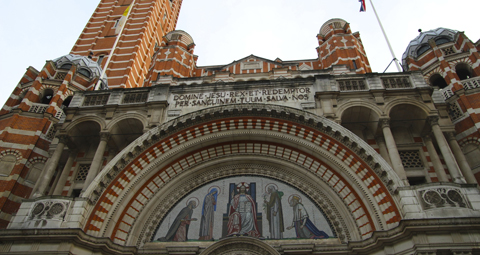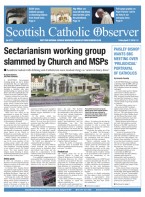April 13 | ![]() 0 COMMENTS
0 COMMENTS ![]() print
print

An Eastertide tale of two cathedrals
ROSS AHLFELD recalls two influential strands of spirituality which helped him keep Faith with the Church — By ROSS AHLFELD
Now that the period of Lent has drawn to a close and as we enter fully into Eastertide, I find myself reflecting on two different cathedrals: an Easter pilgrimage to Westminster Cathedral very many years ago and—one of the best things about this point in the liturgical year—the excellent Paisley Diocese Lenten talks at St Mirin’s Cathedral.
If you want to grow in Faith then these events are perfect. Unfortunately, I was unable to attend Fr Thomas Boyle’s recent talk on the ‘prayer of the heart.’ Fortunately for me, Fr Boyle was at St Ninian’s Church here in Gourock for many years when I was a teenager and I was privileged to hear him speak often about the ‘Jesus Prayer’ and aspects of contemplative and meditative prayer in the Church.
Fr Boyle’s basic argument was that young Catholics need not abandon the true Faith in the pursuit of exotic, new-age and mystical Eastern spirituality when similar spiritual exercises have been present within our own rich tradition for more than 1,000 years. A good example would be the aforementioned ‘Jesus Prayer’ and other contemplative prayers as well as the tradition of meditating on certain scenes from the Gospels. In other words, why go out for a bottle of Blue Nun when you have Chateauneuf du Pape at home?
At the time, Fr Boyle’s homilies really spoke to me; they even introduced me to the spirituality of the Byzantine Catholic Church in Ukraine and Russia and, in truth, this probably kept me in the Church. What I mean by this is that I’ve never been much of a strict ‘fideist.’
Fideism is an epistemological theory which maintains that Faith is independent of reason, or that reason and Faith are hostile to each other. The great scholastic wisdom of the Catholic Faith has always appealed to me and I’ve always thought deeply about the Faith.
The danger here is, of course, in the risk of pure, cold reason leading to a loss of Faith if we don’t continue to maintain a firm prayer and Sacramental life. Yet, as many great Catholic philosophers have stated, reason and logic can also be a path to God since the truth of such things ultimately comes from God too.
For example, the affirmation contained within the Jesus Prayer, ‘Lord Jesus Christ, Son of God, have mercy on me a sinner,’ is very much a logical and philosophical statement, but it’s also a deeply contemplative prayer which takes us into the very heart of the sacred mystery.
This paradoxical aspect of the Faith greatly appealed to me because, back when Fr Boyle was at St Ninian’s, I was especially interested in the music of Arvo Part, Russian literature and the religious and philosophical ideas of writers such as Tolstoy and Dostoevsky.
I was what the Russians might call a ‘Doukhobor,’ that is to say, a ‘spirit wrestler’ or ‘truth seeker’ or a radical Christian anarchist-pacifist, very much in the Tolstoyan tradition. Therefore, learning about the eastern rite, St Seraphim of Sarov and St John of Kronstadt, and the Jesus Prayer appealed to me intellectually and kept me from the self-centred vanity of drifting fully into a Tolstoyan Christianity: a Christianity which was anarcho-socialist, strictly non-violent and based solely on the Sermon on the Mount, but lacking in any true divinity or belief in Jesus as the Son of God.
Fr Boyle’s sermons kept me in the Church because he was able to point me down a path within the broad Church which could open me up to an awareness of God on both a spiritual and an intellectual level. In this sense, good priests are like great football managers who can get the best out of their players by identifying their strengths and playing them in the right position.
This is why; if you chat to a priest for more than 10 minutes, you usually end up with a job doing something or other in the parish. This is mainly because most of our priests are blessed with the skill of identifying gifts given from the Holy Spirit to each and every individual to build up the Kingdom of God for the good of the Church.
Indeed, their job is to help and encourage us towards our own personal vocation within the Church and society, wherever it might be found. Or, as Tolstoy said: “Just as one candle lights another and can light thousands of other candles, so one heart illuminates another heart and can illuminate thousands of other hearts.”
Another example would be Mgr Tom Monaghan who was also here at St Ninian’s while Fr Boyle was here in the 1990s. In Gourock we still call it the ‘Twa Tam Years.’
This was back in the good old days when we still had two priests in some parishes (as opposed to our current state of affairs; no priests in some parishes). Mgr Monaghan was always on hand to answer my endless existentialist questions and, like Fr Boyle, he could see the risk in an over-reliance on reason and logic. Just as Fr Boyle appealed to my interest in philosophy and literature, Mgr Monaghan appealed directly to my interest in politics and social justice.
Specifically, the monsignor paraphrased the words of John F Kennedy in encouraging me to ask not what God could do for me, but rather what I could do to serve Him. This remains excellent advice for anyone struggling with Faith, like practising the Jesus Prayer; we come to experience God, not by waiting around but through our own efforts and devotions.
The great revelation here is to be found in the fact that carrying out the spiritual and corporal works of mercy is in itself a search for God and an encounter with Jesus.
For me, this advice culminated in me being promptly co-opted into becoming a parish catechist and joining the RCIA group (after one of those infamous 10-minute chats with the priest) which in turn helped me to find my own home in the Church.
This was back in 1999 and by the following Easter, I entered Westminster Cathedral through the Pilgrim Door which had been sealed with holy oil by Cardinal Basil Hume to inaugurate the Jubilee Year of 2000.
You may recall that, during this holy year, pilgrims could obtain an indulgence through a visit to a cathedral church. I chose Westminster Cathedral because I really wanted to pray at the tomb of the great Cardinal Henry Edward Manning.
For Catholics on the political left, Cardinal Manning is basically the Karl Marx of the Christian Socialist Movement due to his pivotal role in the London Dockers Strike of 1889. The Dock Strike was a significant event in the history of British trade unionism and workers rights, and we Catholics should be glad that Cardinal Manning played such a critical role in resolving the strike in favour of the dockers.
Cardinal Manning was also an influential figure in the development of Pope Leo’s 1891 encyclical Rerurm Novarum, which itself confirms the Church’s support for organised labour and our right to form trade unions.
For me, the modern labour and trade union movement has sadly traded in this bountiful Christian heritage in favour of liberalism and an over-emphasis on statism as opposed to virtue and self improvement.
It’s also worth noting that when the labour movement was more religious it was also more working-class. All of the 29 of the Labour MPs elected in 1906 were working men and, by the early 1920s, 45 out of 192 Labour MPs were also nonconformist lay preachers.
I have two wee mementos from this time: one object is a striking framed print of the trade union banner of the Amalgamated Watermen and Lightermen, Greenwich Branch, which features a portrait of Cardinal Manning. Although religious imagery was common on early trade union banners, Cardinal Manning remains the only known depiction of an identifiable Catholic leader on a trade union banner.
The other is a small piece of Roman-era silver found in the Holy Land marked with a cross and with ‘2000’ molded onto it. My wife Jane gave me this medallion as a gift to mark my full and complete return back in to the Church.
I still cherish this precious little sacramental as a token of my pilgrimage and also as a practical aid to the contemplations and mediations which I learned from Fr Boyle. By Easter 2004, Jane had also been received into the Church by Mgr Monaghan, taking St Brigid of Kildare as her Confirmation name—and in doing so escaped RCIA classes forever, unlike myself.
Of course I’m joking, but if it seems as if I write a lot about the relationship between clergy and laity, it’s because I feel that it’s one of the most vital, undervalued and misunderstood relationships in the Church today. Some among the laity even seem to see some conflict with our clergy, as if hierarchy is to be somehow ‘overcome.’ This is to misunderstand totally our unity and our own Baptismal vows and the universal call to holiness.
Also, as a lay writer on Church matters, it’s also quite useful to befriend the priests, so that if you ever get called up in front of Church authorities for writing something theologically unsound or wildly heterodox, then you can always just throw the clergy under the bus by saying: “I dunno your Grace, I learned it all from my parish priest” (Yes, I’m kidding again).
I should also say that I still consider Tolstoy’s Christian pacifism to be quite relevant and consider him to be a great writer, despite rejecting some aspects of his religious philosophy. Pope Emeritus Benedict XVI also loved Dostoyevsky and Tolstoy’s literary works and spoke of them both often.
In 2007, Pope Benedict gave a sermon quoting Tolstoy’s story of the shepherd who exchanges clothes with the king to understand how Jesus shed his own divine splendour. Then in Lumen Fidei, he emphasised the vital part played by beauty in everyday human life by quoting Dostoyevsky: “Man can live without science, he can live without bread, but without beauty he could no longer live.”
Finally, if there’s a point to all this, then it’s simply to say that it is possible for us lay people to struggle and to have a great adventure in Faith while remaining entirely faithful to the teaching and authority of Mother Church.
Yes, it can be a difficult road. Sure, you might make some awful mistakes along the way, just as I have, but it’s always worth the struggle. The last lines of Tolstoy’s epic War and Peace offers a insight into the great hope of the Christian life, even lived in times of difficulty: “They say: sufferings are misfortunes, we imagine that as soon as we are torn out of our habitual path all is over, but it is only the beginning of something new and good. As long as there is life, there is happiness. There is a great deal, a great deal before us.”











